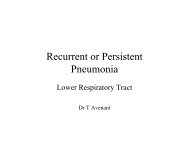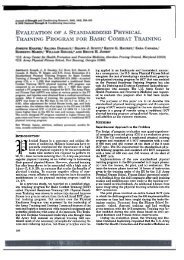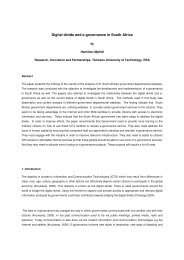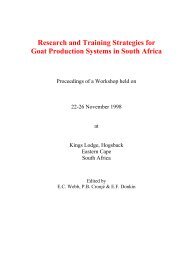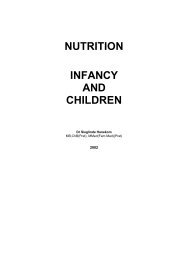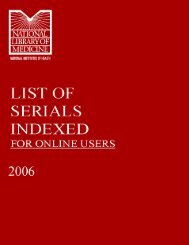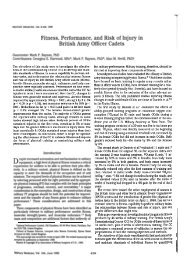Summer 2007 - Library - University of Pretoria
Summer 2007 - Library - University of Pretoria
Summer 2007 - Library - University of Pretoria
- TAGS
- pretoria
- www.ais.up.ac.za
You also want an ePaper? Increase the reach of your titles
YUMPU automatically turns print PDFs into web optimized ePapers that Google loves.
O P N E W S<br />
4<br />
U N I V E R S I T Y O F P R E T O R I A<br />
Crocodiles indicate<br />
ecosystem health<br />
Few people know that crocodiles are surviving<br />
representatives <strong>of</strong> the dinosaurs. In structure,<br />
and probably also in habits, crocodiles have<br />
changed little since the dinosaur era that ended<br />
some 70 million years ago. Only a single species,<br />
the Nile crocodile, Crocodylus niloticus, occurs<br />
in South Africa. The Nile crocodile ranks as one<br />
<strong>of</strong> the most dangerous crocodilians in the world,<br />
surpassed only by the Australian Estuarine<br />
crocodile, C. porosus.<br />
Larger crocodiles have few predators, the<br />
foremost <strong>of</strong> which is man. Crocodiles survived for<br />
millions <strong>of</strong> years, but now they are struggling to<br />
survive and have nearly disappeared completely<br />
from southern Africa. Habitat destruction and<br />
conflict between humans and crocodiles are<br />
probably the most important contributing factors.<br />
Aquatic pollution is also playing a significant<br />
contributing role.<br />
There are few crocodile populations left in South<br />
Africa outside its national parks. Loskop Dam<br />
A dead crocodile from the Loskop Dam ready for a post mortem.<br />
used to support a healthy population <strong>of</strong> crocodiles,<br />
but regular spotlight surveys clearly show that<br />
the total number <strong>of</strong> crocodiles is declining at an<br />
alarming rate, with only 11 individual animals<br />
counted during 2006. The population density<br />
is extremely low, considering the available<br />
shoreline <strong>of</strong> the dam. Another disturbing factor<br />
is that the population structure <strong>of</strong> the crocodiles<br />
in this dam is completely abnormal. There are no<br />
mature crocodiles larger than 2.1 m. Crocodiles<br />
only become reproductively active when they<br />
are bigger than 2.3 m. Fifteen young crocodiles<br />
were released during <strong>2007</strong>.<br />
Aquatic scientists studying the effects that<br />
aquatic pollutants have on crocodiles, rely<br />
solely on blood samples to monitor these<br />
effects. However, we discovered that an<br />
additional biological sample, urine, can be<br />
collected successfully from live crocodiles.<br />
Collection <strong>of</strong> urine from the cloaca is a simple<br />
procedure. An ordinary dog urinary catheter is<br />
used to collect “clean” urine from the urodeum<br />
by Jan Myburgh, Department <strong>of</strong><br />
Paraclinical Sciences, Onderstepoort<br />
Crocodiles, as top predators in the aquatic ecosystem,<br />
are considered to be very important and valuable bioindicators<br />
<strong>of</strong> aquatic health. Trends in South African water sources<br />
these days, however, are an alarming cause for concern.<br />
in the cloaca, in an a-traumatic way. Strict<br />
separation <strong>of</strong> urine from faeces in the cloaca<br />
<strong>of</strong> the crocodile is very similar to that in the<br />
ostrich. The faeces are stored in the rectum<br />
(coprodeum) and held back by a powerful<br />
sphincter (coprodeal sphincter) separating the<br />
coprodeum from the urodeum.<br />
During a recent visit to Loskop and the<br />
Blyderivierspoort dams, a team <strong>of</strong> international<br />
crocodile researchers from the <strong>University</strong> <strong>of</strong><br />
<strong>Pretoria</strong> (Hannes Botha, Dirk Booyse and Jan<br />
Myburgh), <strong>University</strong> <strong>of</strong> Florida, USA (Lou<br />
Guillette), <strong>University</strong> <strong>of</strong> Stellenbosch (Hannes<br />
van Wyk) and the Mpumalanga Parks Board<br />
(Koos de Wet) caught several crocodiles for<br />
an ecological study. Blood and urine samples<br />
were collected from each crocodile to further<br />
investigate the diagnostic value <strong>of</strong> urine.<br />
A urinary catheter is inserted in a craniodorsal<br />
direction via the cloacal opening. It is<br />
recommended to start at the caudal end <strong>of</strong> the<br />
cloacal opening to get a better angle and the<br />
catheter is gently pushed in a cranial direction.<br />
The urodeum is not far from the cloacal opening.<br />
This collection technique is extremely simple<br />
and a-traumatic, and could easily be used by any<br />
scientist with no previous clinical experience.<br />
Urine is routinely used in human and other<br />
animal patients to diagnose endocrine<br />
problems. Excretion <strong>of</strong> steroid hormones or<br />
metabolites in urine has been well studied in<br />
humans. Urine steroid pr<strong>of</strong>iling in humans<br />
can be indicative <strong>of</strong> numerous endocrine








